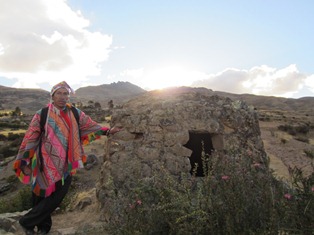We have been working with a community called Media Luna which is planning to achieve this industry for them. There is a lot of work involved in the preparation of creating a community ready to serve tourists. Experiential tourism allows outside parties to have a living and breathing experience. You learn all about the community, what their challenges are and how they survive. The communities in the sacred valley all have different strengths and different aspects that make them unique. We are focusing on the strengths of the community in Media Luna for further development and have begun with the steps necessary to create this industry for them. Nexos Voluntarios will be working with a local capacity development organization named Arariwa which will begin workshops in September. We have also begun workshops on computer skills. Our project does face many challenges; for example, the organization and participation of the community at times, the level of education of the community and the proper practices of the daily activities of involved in the tourism project. It is very important that the involved members of the community in the project deliver a safe and friendly product. To gain a full grasp as to how this type of tourism functions we visited two successful communities with this same type of tourism; Amaru, and Misminay.
Our first visit was to Amaru where we traveled by bus to Pisac where our guide and community member met us with a taxi. We took the tax well above Pisac to 3500 feet roughly. Our group met the community with a very warm introduction and showed us the community and served us mate(tea).
Following this our group began a long journey up the mountain. During this walk we discovered and learnt many new things about the life of the people, their utilization crops and plants and the efforts that go into daily activities.
Once we reached the top of the mountain we were joined by a group of Amaru ladies who were carrying an amazing three course meal with more mate. After our lunch we travelled as a group to see the herd of alpaca that were a few hundred feet above us, then down to view one of the lagoons. We encountered an ancient style house with human bones inside and finally after a long trek made it back into town where we were served dinner.
The night was an early night and the morning was an early morning. Our group participated in some cultural activities and dressed in some traditional clothing. We danced to local music and witnessed the complexity of weaving as one of the main crafts of the females in the communities.

This two day visit to the community of Amaru was a very great experience. All activities seemed to flow and were very well sequenced which was great. The level of hospitality was pleasant as well. Amaru was the bi-product of Arariwa’s capacity training a few years back.
The other location that we visited was Misminay. Our visit was for a similar purpose but with a twist. We were there to view how things were done, however, we were also there to be part of the creation of a promotional TV show on experiencial tourism that will be on Haciendo Peru.
We travelled up the mountain to Misminay where we were at cloud level. Our bus stopped before entering the community and that is when lights, cameras, action began. We exited out of the bus with film rolling, the community playing instruments and welcoming us into the community. From there, we filmed different segments and on breaks talked with the locals. After a day of filming the night was spent sharing stories with the local community and participating in dance. We had a big fire and live music playing during the night.
The next day we all went horseback riding, mountain biking and visited the houses of a couple community members who demonstrated how to make mud bricks (which are used for the creation of houses here), how to colour wool and weave, and how to use local plants are medicine for different ailments. After these activities we ate a large feast and drank chicha (fermented corn). Now all was good with this tour and the community was very experienced in receiving guests, however, we may have found an area that needs attention.
Attention and improvements can always be made by anyone, or any organization everwhere in the world. This noticeable need for change we believe may be needed in the production of the chicha. After the final day Ronny, the TV host, and myself became very ill. I was put in the hospital with severe dehydration from a fever derived from a bacterial infection and I also had a parasite. This past week was not a pleasant one and was spent in my bed. These little occurrences are the risks that need to be eliminated from experiential tourism and must be stressed. This is something that we can stress and pay acute attention to when working with Media Luna. In Media Luna, one of the activities is the production of chicha. It is the responsibility of the community to deliver a safe product to the customers and it is the role of the communities’ support system to train methods of achieving this success.
Our road to the development of Media Luna is a long road, but the motions have been in play and we are continuously bridging connections with hotels, and Urubamba.









Beautiful photos Derek :) It really shows that you are fully submerging yourself in the culture. Hope everything is wonderful.
ReplyDeleteAbrazos
Amber